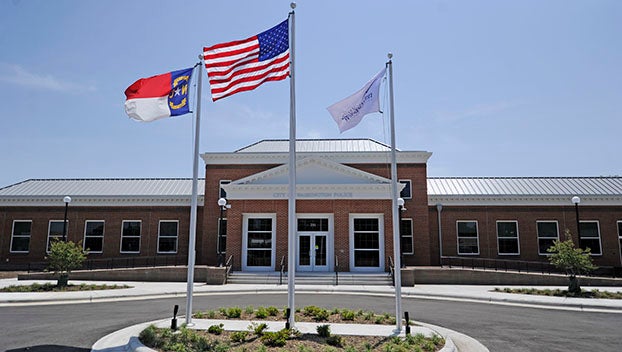Congress returns for a short session
Published 10:30 pm Monday, September 10, 2012
WASHINGTON — Congress returned to Washington on Monday for an abbreviated pre-election session in which it appears likely to do the bare minimum: making sure that the government doesn’t shut down.
Almost everything else of consequence, most notably a set of automatic, economy-rattling spending cuts and tax increases that have been dubbed a “fiscal cliff,” will get put off until a postelection lame duck session — and maybe beyond.
Top lawmakers unveiled a six-month spending bill that would finance the government’s day-to-day operations until next March to give the next Congress and whoever occupied the White House time to work out a final solution on more than $1 trillion in annual spending for the Pentagon and other Cabinet departments.
Typically such temporary funding bills, known in Washington parlance as continuing resolutions, or CRs, freeze spending at current levels. But the measure released Monday actually allows for a 0.6 percent increase to every program to keep pace with a slight increase in spending permitted by “caps” set by last summer’s hard-fought budget and debt accord.
The 2012 budget year ends on Sept. 30. But not a single one of the 12 annual agency appropriations bills has become law, requiring lawmakers to step in with the stopgap funding measure to avoid a disastrous partial shutdown of the government.
Just a handful of high priority programs would be awarded larger increases, including a government cybersecurity initiative, wildfire suppression efforts, a drive to modernize the U.S. nuclear arsenal and processing of veteran disability claims. A popular initiative to repair the dome of the Capitol was left unfunded, however, despite a high-profile push by Senate Democrats.
The House is to vote on the six-month spending bill Thursday, and it appears set to pass easily, even though many tea party conservatives are upset that it would allow more spending than would be permitted under a GOP budget plan that passed the House this spring.
Less certain is whether a badly gridlocked Congress will be able to find a solution on what to do about food aid and farm subsidies set to expire at the end of the month.
The Senate has passed a five-year farm bill to overhaul crop safety net programs while funding food stamps for more than 46 million people. But the food and farm legislation has bedeviled House leaders because many GOP conservatives want deeper cuts to food stamps than Democrats, whose votes are needed to pass the measure, are willing to support.
House Majority Whip Kevin McCarthy, R-Calif., said Monday that GOP leaders intend to bring the measure to the floor before the election, though the measure has yet to appear on any floor schedule. Probably more likely is an attempt to temporarily extend the old bill, including drought aid for livestock producers whose assistance programs expired last year.
But it’s not certain lawmakers will do even that. Without a formal extension, food stamp and other nutrition programs would continue to function beyond Sept. 30. Most farmers would not be affected because the current farm bill covers 2012 crops regardless of when they are harvested.
Republicans have, however, slated votes this week in hopes of embarrassing Democrats over an Energy Department scandal and the failure by Senate Democrats to offer a plan to forestall the automatic spending cuts set to strike the Pentagon and domestic agencies as punishment for the failure of last year’s deficit “supercommittee” to strike a budget deal.
On Friday, Republicans promise a vote on a bill dubbed the “No More Solyndras Act,” which would phase out Energy Department loan guarantees for solar and wind energy companies. It’s unlikely to even get a vote in the Senate.
Solyndra Inc. went bankrupt last year after receiving a loan guarantee from the Obama administration, even as some White House aides raised red flags. The California company’s failure left taxpayers on the hook for $500 million.
On Thursday comes a House vote on the ambitiously titled “National Security and Job Protection Act.” It’s a curiously-drafted 10-page bill that would turn off the automatic spending cuts — conditioned on Congress separately enacting a big package of spending cuts. If Congress were to pass such a bill, of course, lawmakers would use that legislation to block the across-the-board cuts.
The abbreviated September session — expected to last no longer than this week and next — leaves a huge pile of business for a lame duck session.
Topping the list is the expiration of the full menu of President George W. Bush-era tax cuts on Dec. 31. The resulting tax increases, when combined with more than $100 billion in automatic across-the-board spending cuts set to take effect at the same time, have become known as the fiscal cliff. Economists warn that unless Congress acts, the one-two austerity punch would send the fragile economy back into recession.
The automatic cuts are punishment for the inability of last year’s deficit reduction “supercommittee” to strike a bargain to cut 10-year deficits by at least $1.2 trillion as promised by last summer’s debt and budget pact. The Bush tax cuts were originally set to expire at the end of 2010 but were renewed two years ago. President Barack Obama promises to raise the top tax rate on upper bracket earners back to the Clinton-era level of 39.6 percent, up from 35 percent now.
There’s no certainty that Congress will handle the issue in the lame duck session, especially if Mitt Romney retakes the White House for Republicans.





